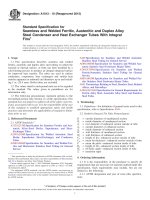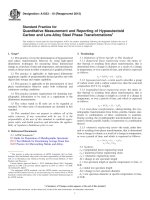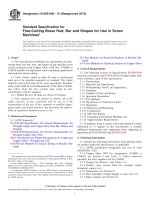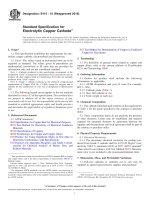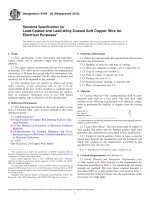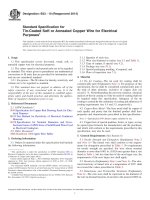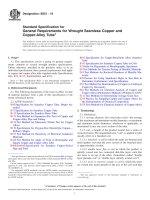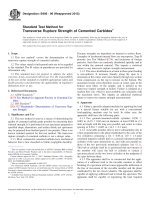Astm b 645 10 (2015)
Bạn đang xem bản rút gọn của tài liệu. Xem và tải ngay bản đầy đủ của tài liệu tại đây (168.13 KB, 6 trang )
Designation: B645 − 10 (Reapproved 2015)
Standard Practice for
Linear-Elastic Plane–Strain Fracture Toughness Testing of
Aluminum Alloys1
This standard is issued under the fixed designation B645; the number immediately following the designation indicates the year of
original adoption or, in the case of revision, the year of last revision. A number in parentheses indicates the year of last reapproval. A
superscript epsilon (´) indicates an editorial change since the last revision or reapproval.
This standard has been approved for use by agencies of the U.S. Department of Defense.
INTRODUCTION
Linear-elastic plane-strain fracture toughness testing of aluminum alloys is performed essentially in
accordance with Test Method E399. However, there is a need, in the application of Test Method E399
for quality assurance testing, to deal with the interpretation of the results for material qualification and
release in cases where all requirements for valid measurements of plane-strain fracture toughness
cannot be met. It is the purpose of this practice to provide consistent methods of dealing with those
situations.
priate safety and health practices and determine the applicability of regulatory limitations prior to use.
1. Scope*
1.1 This practice is applicable to the fracture toughness
testing of all aluminum alloys, tempers, and products, especially in cases where the tests are being made to establish
whether or not individual lots meet the requirements of
specifications and should be released to customers.
2. Referenced Documents
2.1 ASTM Standards:2
B646 Practice for Fracture Toughness Testing of Aluminum
Alloys
E29 Practice for Using Significant Digits in Test Data to
Determine Conformance with Specifications
E399 Test Method for Linear-Elastic Plane-Strain Fracture
Toughness KIc of Metallic Materials
E561 Test Method forK-R Curve Determination
E1823 Terminology Relating to Fatigue and Fracture Testing
1.2 Test Method E399 is the basic test method to be used for
plane-strain fracture toughness testing of aluminum alloys. The
purpose of this practice is to provide supplementary information for plane-strain fracture toughness of aluminum alloys in
three main areas:
1.2.1 Specimen sampling,
1.2.2 Specimen size selection, and
1.2.3 Interpretation of invalid test results.
3. Terminology
1.3 The values stated in SI units are to be regarded as
standard. No other units of measurement are included in this
standard.
1.3.1 Exception—Certain inch-pound values given in parentheses are provided for information only.
3.1 General—Terms, definitions, symbols, and orientation
designations in Test Method E399 and Terminology E1823 are
applicable herein.
3.2 Definitions:The following additional definitions are applicable:
3.2.1 invalid plane-strain fracture toughness—test result,
KQ, that does not meet one or more of the validity requirements
in Test Method E399 and, where so characterized, is of no
value in judging the true plain-strain fracture toughness of a
material but may, under certain conditions, adequately guarantee the material’s fracture toughness for lot release purposes.
1.4 This standard is currently written to accommodate only
C(T) specimens.
1.5 This standard does not purport to address all of the
safety concerns, if any, associated with its use. It is the
responsibility of the user of this standard to establish appro-
1
This practice is under the jurisdiction of ASTM Committee B07 on Light
Metals and Alloys and is the direct responsibility of Subcommittee B07.05 on
Testing.
Current edition approved Dec. 1, 2015. Published December 2015. Originally
approved in 1978. Last previous edition approved in 2010 as B645 – 10. DOI:
10.1520/B0645-10R15.
2
For referenced ASTM standards, visit the ASTM website, www.astm.org, or
contact ASTM Customer Service at For Annual Book of ASTM
Standards volume information, refer to the standard’s Document Summary page on
the ASTM website.
*A Summary of Changes section appears at the end of this standard
Copyright © ASTM International, 100 Barr Harbor Drive, PO Box C700, West Conshohocken, PA 19428-2959. United States
1
B645 − 10 (2015)
3.2.2 valid plane-strain, fracture toughness—test result
meeting all the validity requirements in Test Method E399, that
is, a value of KIc.
8. Test Specimen Configuration and Dimensions
8.1 Specimen size requirements stated in the individual
material specifications shall be followed. In the absence of
specific requirements, the specimen types, general
configuration, and size requirements in Test Method E399 are
applicable herein with the following supplemental recommendations and requirements:
8.1.1 For aluminum products, the recommended minimum
specimen ligament length is:
4. Summary of Practice
4.1 This practice supplements Test Method E399 and Practice B646 in three main areas:
4.1.1 Specimen sampling,
4.1.2 Specimen size selection, and
4.1.3 Interpretation of results that fail the validity requirements in Test Method E399 in one of the following areas in
order to determine if the invalid results are usable for lot
release:
4.1.3.1 Pmax/PQ requirements,
4.1.3.2 Specimen size requirements, and
4.1.3.3 Fatigue precracking requirements.
S D
K
2
~ W 2 a ! $ 5· σ Q
YS
rather than the required minimum of:
S D
K
(1)
2
~ W 2 a ! $ 2.5· σ Q
YS
in Test Method E399.
(2)
NOTE 2—Experimental studies3 have shown that more uniform values
of KQ are obtained for high toughness aluminum alloys when the
conditions of Eq 1 are met.
5. Significance and Use
5.1 This practice for plane-strain fracture toughness testing
of aluminum alloys may be used as a supplement to Test
Method E399. The application of this practice is primarily
intended for quality assurance and material release in cases
where valid plane-strain fracture toughness data cannot be
obtained per Test Method E399.
8.1.2 In all cases, the specimen W/B ratio shall be greater
than or equal to 2 and less than or equal to 4 based on nominal
specimen dimensions. Other specimen dimensional proportions in Test Method E399 shall also be maintained.
NOTE 3—Specimens meeting this requirement correspond to the standard (W/B = 2) or alternative specimen geometries (2 ≤ W/B ≤ 4) in Test
Method E399.
5.2 It must be understood that the interpretations and
guidelines in this practice do not alter the validity requirements
of Test Method E399 or promote the designation of data that
are invalid according to Test Method E399 to a “valid”
condition. This practice is primarily concerned with cases
where it is not possible or practical to obtain valid data, but
where material release judgments must be made against
specified fracture toughness values. Where it is possible to
obtain a valid plane-strain fracture toughness value by replacement testing according to Test Method E399, that is the
preferred approach.
8.1.3 When the minimum size requirement of:
S D
K
2
~ W 2 a ! $ 2.5· σ Q
YS
in Test Method E399 cannot be met due to product dimensional constraints, the specimen shall be machined such that
the W dimension is maximized to the nearest 12.7 mm (0.5
in.) at the specified test location while still meeting the requirements of 8.1.2 up to the specimen width required in the
applicable material specification, or if no width is specified,
up to an upper required limit of 127 mm (5.0 in.).
NOTE 4—It is not practical for W to vary continuously (that is,
non-discretely) since many C(T) specimen dimensions are proportional to
W. Each change in W requires a different machining or testing setup.
Therefore, it is required that W be maximized to the nearest 12.7 mm (0.5
in.).
6. Apparatus
6.1 All apparatus shall be in conformance with Test Method
E399.
7. Sampling
8.1.4 When the requirement Pmax/PQ≤ 1.1 cannot be met
due to product dimensional constraints, the specimen shall be
machined such that the B dimension is maximized up to a
required maximum thickness of 63.5 mm (2.5 in.) at the
specified test location. The specimen ligament length should be
maintained at:
7.1 Sampling requirements stated in the individual material
specifications shall be followed. In the absence of specific
requirements in the individual material specifications, specimens shall be taken at the following locations:
7.1.1 Specimens from plate shall be from the mid-thickness,
until the plate thickness is twice the standard specimen
thickness for that particular product (that is, the specimen
thickness selected for lot release and quality assurance testing
which typically yields a valid KIc for that particular alloy and
product), at and beyond which the specimen shall be centered
at the quarter-thickness location.
7.1.2 Specimens from forgings, extrusions, and rod shall be
taken from the center of the cross section as far as is practical.
S D
K
2
(3)
~ W 2 a ! $ 2.5· σ Q
YS
or as large as possible while still meeting the requirements
of 8.1.2, up to the specimen width required in the applicable
material specification, or if no width is specified, up to an
upper required limit of 127 mm (5.0 in.).
NOTE 5—The upper limit on specimen thickness and width have been
established because of practical limitations on how large a specimen can
NOTE 1—Considerable care should be taken in specifying the location
of specimens within the thickness of the thick plate, forgings, extrusions,
or rod because fracture toughness may vary appreciably with location
through the thickness.
3
Kaufman, J. G., “Experience in Plane Strain Fracture Toughness per ASTM
E399,” Developments in Fracture Mechanics Test Methods Standardization, ASTM
STP 632, ASTM, 1977, pp. 3-24.
2
B645 − 10 (2015)
provided that each invalidity meets all of the secondary
conditions in 11.4, 11.5, and 11.6.
be routinely machined and tested for lot release purposes in a production
environment using standard equipment. The producer may test thicker
and/or wider specimens provided the testing capability and sufficient
material are available, and the specimen proportions adhere to the
requirements in 8.1.2.
11.4 Invalidities Related to Specimen Size and Pmax/PQ
Requirements:
11.4.1 In all cases, the specimen W/B ratio must meet the
requirements in 8.1.2. Otherwise, a replacement test shall be
performed using a specimen meeting those requirements.
11.4.2 If a KQ value is invalid because the specimen does
not meet the:
8.1.5 When it is not possible to meet either the:
S D
K
or the:
~ W 2 a ! $ 2.5· σ Q
YS
P max
# 1.1
PQ
2
(4)
(5)
S D
K
2
~ W 2 a ! $ 2.5· σ Q
YS
requirement but the test record meets the:
requirements, then both the W and B dimensions shall be
maximized in accordance with requirements in 8.1.2, 8.1.3,
and 8.1.4.
P max
# 1.1
PQ
NOTE 6—For aluminum products where the size requirement in either
Eqs 4 or 5 cannot be consistently met because of high toughness, even
when B and W are maximized, other measures of fracture toughness such
as KR25 described in Practice B646 or the K-R curve as described in Test
Method E561 should be considered for evaluating fracture toughness for
lot release purposes.
NOTE 7—Test Method E399 permits the use of side-grooved specimens
in certain specimen types. Side-grooved specimens may allow for valid
KIC values to be obtained for high toughness alloys or thin products that
otherwise would have invalidities due to excessive plasticity. For lot
acceptance testing, side-grooved specimens shall not be used unless
specifically allowed by the product specification or by agreement between
producer and user. Side-grooves increase the level of constraint with
respect to the recommended specimen. The increased constraint promotes
a more uniform stress state along the crack front and inhibits shear lip
development. As a result, a KIC value obtained from testing a side-grooved
specimen is expected to be lower than a KIC value obtained from testing
the recommended specimen, particularly for thin products or tests exhibiting Type I behavior. For use of side-grooves in lot acceptance testing,
minimum KIC values specific to side-grooved specimens may need to be
established.
requirement, the KQ value may be usable for lot release if
the specimen width W is maximized according to 8.1.3.
11.4.3 If a KQ value is invalid because the test record does
not meet the:
P max
# 1.1
PQ
requirement but the specimen size does meet the:
S D
K
2
~ W 2 a ! $ 2.5· σ Q
YS
requirement, the KQ value may be usable for lot release if
the thickness is maximized according to 8.1.4.
11.4.4 If a KQ value is invalid because it fails to meet both
the:
P max
# 1.1
PQ
(6)
9. Fatigue Precracking
requirement and the:
9.1 Fatigue precracking shall be performed and fatigue
crack front measurements shall be made in accordance with
Test Method E399.
(7)
~ W 2 a ! $ 2.5· σ Q
YS
requirement, the KQ value may be usable for lot release if
the width W and the thickness B are maximized according to
8.1.5.
S D
K
10. Procedure
2
NOTE 8—Under the conditions in 11.4.2, 11.4.3, and 11.4.4, the KQ
value may not represent or approximate KIc, but it does represent a
measure of the material’s resistance to fracture. KQ values obtained under
these conditions may also depend significantly on the specimen geometry
and dimensions. Therefore, both the specified value and the qualification
testing should be based on a specimen of the same geometry and
dimensions.
10.1 The test procedure, analysis of test record, and calculations shall be made in accordance with Test Method E399.
11. Interpretation of Results
11.1 A KQ value that satisfies all of the validity requirements
of Test Method E399 is a valid KIC in accordance with this
practice. A KQ value that does not meet all of the requirements
of Test Method E399 is not a valid KIC value in accordance
with Test Method E399 or this practice, but is usable for lot
release purposes if all of the appropriate requirements in this
section are met.
11.5 Invalidities Related to Fatigue Precracking:
11.5.1 If the maximum stress intensity in the final stage of
precracking (Kfmax) exceeds the limit of 60% of KQ allowed in
Test Method E399, but still satisfies the requirement that:
K fmax
# 0.00032 m ½ ~ 0.002 in. ½ ! ,
E
the KQ value may be usable for lot release if Kfmax is no
more than 80% of KQ. Otherwise, a replacement test shall be
performed.
11.2 A KQvalue that has invalidities in accordance with Test
Method E399, but which meets the specimen width and
thickness requirements in the individual material specification,
is usable for lot release provided the secondary conditions in
11.5 and 11.6 are met.
11.5.2 If the crack length a determined in accordance with
Test Method E399 is outside the range allowed in E399 (0.45W
to 0.55W), the KQ value may be usable for lot release if the
crack length a is within the range 0.4W to 0.6W. Otherwise, a
replacement test shall be performed.
11.3 In the absence of specific requirements in the individual material specification, a KQ value having invalidities in
accordance with Test Method E399 is usable for lot release
3
B645 − 10 (2015)
12.4 Replacement Tests—A test specimen may be discarded
and a replacement test performed as instructed in 11.4, 11.5,
and 11.6, or when (1) the specimen was machined incorrectly,
(2) the test procedure was incorrect, or (3) the test machine
malfunctioned.
11.6 Other Invalidities: To be usable for lot release, a KQ
value must also satisfy all other validity requirements in Test
Method E399 not covered in 11.4 and 11.5. Otherwise, a
replacement test shall be performed.
11.7 Annex A1 provides a flowchart to help the user
understand how to interpret an invalid KQ value from E399 to
determine if it is usable for lot release according to this
Practice.
12.5 Retests—Retests shall be performed and interpreted in
accordance with the applicable material specification or as
otherwise agreed upon between the purchaser and supplier. If
there is no specific provision for retests, and one or more test
results fail to conform with the requirements of the material
specification after rounding in accordance with 12.3, for
reasons other than those in 12.4, the lot represented by that test
result shall be subject to rejection except as provided below:
12.5.1 For each specimen that failed, retest at least two
additional specimens at the specified test location from an area
in the original sample adjacent the failing specimen, or
12.5.2 For each specimen that failed, retest an additional
specimen at the specified location from at least two other
samples.
12.5.3 If any retest fails, the lot shall be subject to rejection,
except that the lot may be resubmitted for testing provided the
producer has reworked the lot, as necessary, to correct the
deficiencies.
12. Report
12.1 The record shall include all information required by
Test Method E399 and individual reasons for invalid results
being considered usable for lot release in accordance with this
practice.
12.2 The complete record is not normally required for
material certification and lot release purposes. Such records are
usually retained by the producer for future audit by the
purchaser.
12.3 For the purpose of determining conformance with a
specified limit in a material or product specification, the value
of KIc (or KQ when usable for lot release) obtained in the test
shall be rounded “to the nearest unit” in the last right hand
significant digit used in expressing the limiting value in
accordance with the rounding method of Practice E29. For a
limit specified as a whole number, all digits shall be considered
significant including zeros.
13. Keywords
13.1 aluminum alloys; fracture toughness; plane strain;
quality assurance
ANNEX
(Mandatory Information)
A1. FLOWCHART FOR ADDITIONAL INTERPRETATION OF TEST RESULTS INVALID PER TEST METHOD E399
4
FIG. A1.1 Flowchart Showing Logic for Determining if a KQ Value is Usable for Lot Release
B645 − 10 (2015)
5
B645 − 10 (2015)
SUMMARY OF CHANGES
Committee B07 has identified the location of selected changes to this standard since the last revision
(B645 – 07) that may impact the use of this standard. (Approved May 1, 2010)
(1) Sections 8 and 11 were revised to make criteria compatible
with Test Method E399 – 09.
(2) The flowchart in Annex A1 was revised to comply with the
changes to the text.
(3) Equations were updated.
ASTM International takes no position respecting the validity of any patent rights asserted in connection with any item mentioned
in this standard. Users of this standard are expressly advised that determination of the validity of any such patent rights, and the risk
of infringement of such rights, are entirely their own responsibility.
This standard is subject to revision at any time by the responsible technical committee and must be reviewed every five years and
if not revised, either reapproved or withdrawn. Your comments are invited either for revision of this standard or for additional standards
and should be addressed to ASTM International Headquarters. Your comments will receive careful consideration at a meeting of the
responsible technical committee, which you may attend. If you feel that your comments have not received a fair hearing you should
make your views known to the ASTM Committee on Standards, at the address shown below.
This standard is copyrighted by ASTM International, 100 Barr Harbor Drive, PO Box C700, West Conshohocken, PA 19428-2959,
United States. Individual reprints (single or multiple copies) of this standard may be obtained by contacting ASTM at the above
address or at 610-832-9585 (phone), 610-832-9555 (fax), or (e-mail); or through the ASTM website
(www.astm.org). Permission rights to photocopy the standard may also be secured from the Copyright Clearance Center, 222
Rosewood Drive, Danvers, MA 01923, Tel: (978) 646-2600; />
6
